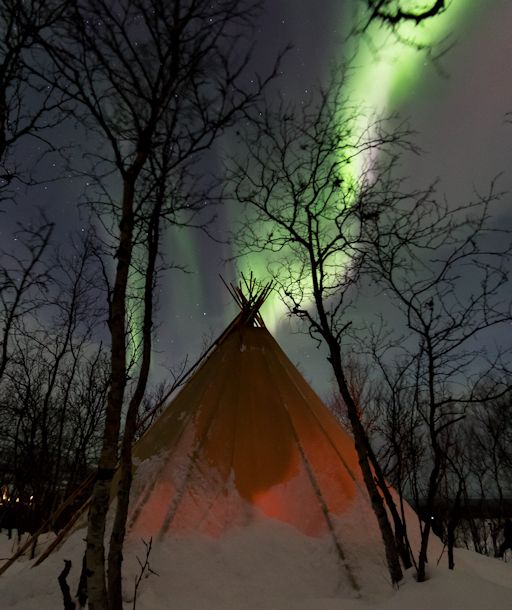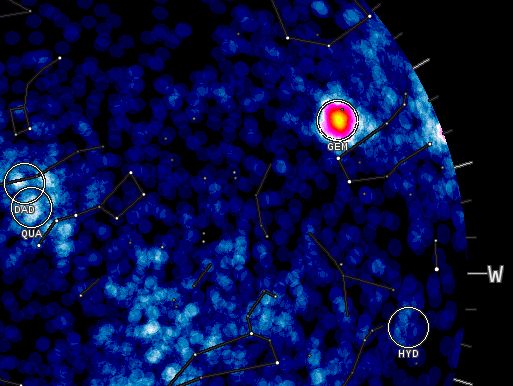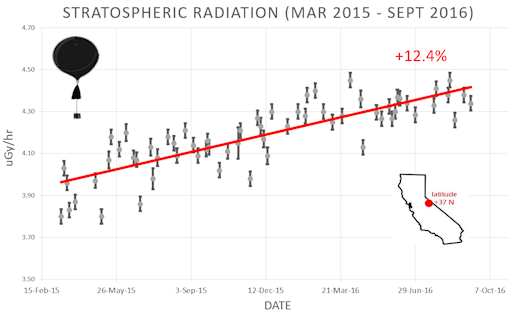Bring in the New Year with Marianne's Arctic Xpress. Spend Christmas or New Year in a remote Norwegian cabin. Chase auroras every night or join a day tour to see fjords, whales, eagles and an abundance of wildlife. Book Now | | | SOLAR WIND SPARKS AURORAS: Earth is now fully inside a stream of solar wind flowing from a large coronal hole on the sun. The buffeting action of the stream is causing intermittent auroras around the Arctic Circle--some of them quite bright. "We had a fantastic display in northern Sweden," reports Oliver Wright, who sends this picture from Abisko National Park: 
"This was an aurora storm within a storm," says Wright, who spent the evening guiding a group of sky watchers for Lights over Lapland. "We went out in 100% clouds, strong winds and blowing snow. Suddenly, the clouds parted and the guests got to see a full-on aurora storm." The stream of solar wind powering these auroras is broad, and it could take Earth two or three days to cross it. Arctic observers should be alert for more lights on Dec.9th and 10th. Free: Aurora Alerts Realtime Aurora Photo Gallery GEMINID METEOR SHOWER: Canada's Meteor Orbit Radar (CMOR) is picking up echoes from the constellation Gemini. It's a sign that the annual Geminid meteor shower is underway. The bright pink "hot spot" in this CMOR sky map shows where Geminid meteoroids are hitting the atmosphere on Dec. 9th: 
Geminid meteoroids are gravelly debris from "rock comet" 3200 Phaethon. They hit Earth's atmosphere traveling ~35 km/s (78,000 mph) and typically disintegrate about 80 km (50 miles) above Earth's surface. While many Geminids are faint, bright fireballs are not unusual. At the moment, visible Geminid meteor rates are no more than a few per hour. Sightings will increase in the nights ahead as Earth plunges deeper into the debris zone of 3200 Phaethon. Forecasters expect peak rates to occur on Dec. 13-14 when observers in both hemispheres could see dozens of Geminids despite the glare of a bright full Moon. The best time to look is during the hours after local midnight. [sky map] Realtime Meteor Photo Gallery STUDENT SPECIAL: Is there a young scientist in your life? For Christmas, you can give them the gift of exploration. For the holiday season only, we're reducing the cost of payload space on Earth to Sky Calculus balloons from $500 to only $299.95. Buy an edge of space gift certificate before Dec. 25th and your student can send an experiment, photo, or keepsake item to the stratosphere, completely supported by an Earth to Sky Calculus launch and recovery team. 
This is not only a great Christmas gift, but also a good kickstarter for science fair projects. Experiments will be flown and returned along with video footage, GPS tracking, temperature, pressure, altimetry and radiation data. To take advantage of the discounted rate, payment must be received before Dec. 25th. However, the flight can take place at any time in the next 12 months. A Skype brainstorming session is included with each certificate. Dr. Tony Phillips and other members of the Earth to Sky team will chat with students to help them craft an experiment that will work in the harsh environment of the stratosphere. More far out Christmas gifts may be found in the Earth to Sky Store. All proceeds support space weather research. Realtime Space Weather Photo Gallery
Realtime Airglow Photo Gallery
Realtime Sprite Photo Gallery Every night, a network of NASA all-sky cameras scans the skies above the United States for meteoritic fireballs. Automated software maintained by NASA's Meteoroid Environment Office calculates their orbits, velocity, penetration depth in Earth's atmosphere and many other characteristics. Daily results are presented here on Spaceweather.com. On Dec. 9, 2016, the network reported 40 fireballs.
(29 sporadics, 6 Geminids, 4 sigma Hydrids, 1 sigma Serpentid)  In this diagram of the inner solar system, all of the fireball orbits intersect at a single point--Earth. The orbits are color-coded by velocity, from slow (red) to fast (blue). [Larger image] [movies] Potentially Hazardous Asteroids ( PHAs) are space rocks larger than approximately 100m that can come closer to Earth than 0.05 AU. None of the known PHAs is on a collision course with our planet, although astronomers are finding new ones all the time. On December 9, 2016 there were potentially hazardous asteroids. Notes: LD means "Lunar Distance." 1 LD = 384,401 km, the distance between Earth and the Moon. 1 LD also equals 0.00256 AU. MAG is the visual magnitude of the asteroid on the date of closest approach. | | Cosmic Rays in the Atmosphere |
Readers, thank you for your patience while we continue to develop this new section of Spaceweather.com. We've been working to streamline our data reduction, allowing us to post results from balloon flights much more rapidly, and we have developed a new data product, shown here: 
This plot displays radiation measurements not only in the stratosphere, but also at aviation altitudes. Dose rates are expessed as multiples of sea level. For instance, we see that boarding a plane that flies at 25,000 feet exposes passengers to dose rates ~10x higher than sea level. At 40,000 feet, the multiplier is closer to 50x. These measurements are made by our usual cosmic ray payload as it passes through aviation altitudes en route to the stratosphere over California. What is this all about? Approximately once a week, Spaceweather.com and the students of Earth to Sky Calculus fly space weather balloons to the stratosphere over California. These balloons are equipped with radiation sensors that detect cosmic rays, a surprisingly "down to Earth" form of space weather. Cosmic rays can seed clouds, trigger lightning, and penetrate commercial airplanes. Furthermore, there are studies ( #1, #2, #3, #4) linking cosmic rays with cardiac arrhythmias and sudden cardiac death in the general population. Our latest measurements show that cosmic rays are intensifying, with an increase of more than 12% since 2015: 
Why are cosmic rays intensifying? The main reason is the sun. Solar storm clouds such as coronal mass ejections (CMEs) sweep aside cosmic rays when they pass by Earth. During Solar Maximum, CMEs are abundant and cosmic rays are held at bay. Now, however, the solar cycle is swinging toward Solar Minimum, allowing cosmic rays to return. Another reason could be the weakening of Earth's magnetic field, which helps protect us from deep-space radiation. The radiation sensors onboard our helium balloons detect X-rays and gamma-rays in the energy range 10 keV to 20 MeV. These energies span the range of medical X-ray machines and airport security scanners. The data points in the graph above correspond to the peak of the Reneger-Pfotzer maximum, which lies about 67,000 feet above central California. When cosmic rays crash into Earth's atmosphere, they produce a spray of secondary particles that is most intense at the entrance to the stratosphere. Physicists Eric Reneger and Georg Pfotzer discovered the maximum using balloons in the 1930s and it is what we are measuring today. | | The official U.S. government space weather bureau | | | The first place to look for information about sundogs, pillars, rainbows and related phenomena. | | | Researchers call it a "Hubble for the sun." SDO is the most advanced solar observatory ever. | | | 3D views of the sun from NASA's Solar and Terrestrial Relations Observatory | | | Realtime and archival images of the Sun from SOHO. | | | from the NOAA Space Environment Center | | | a proud supporter of science education and Spaceweather.com | | | the underlying science of space weather | | | These links help Spaceweather.com stay online. Thank you to our supporters! | | 
